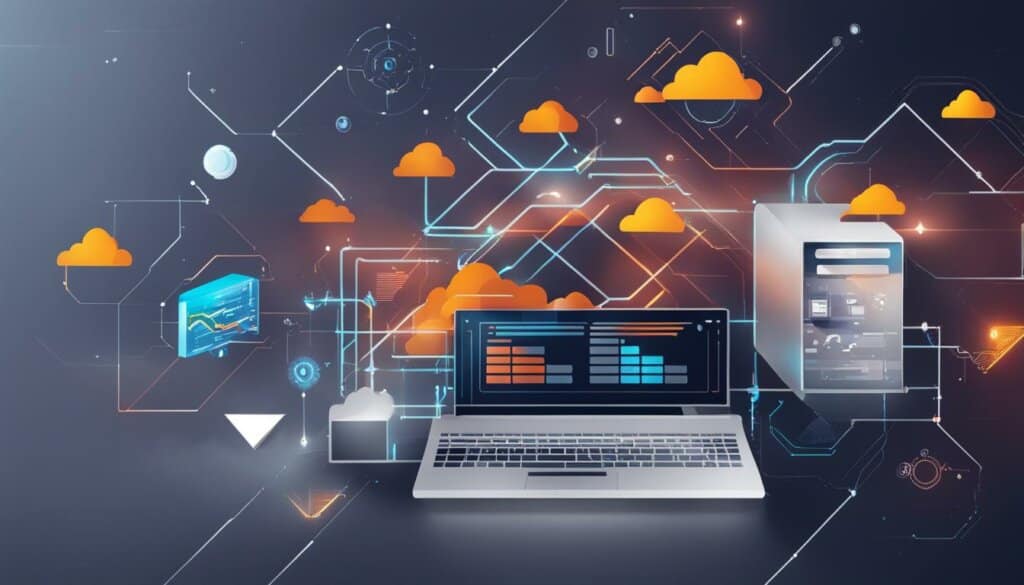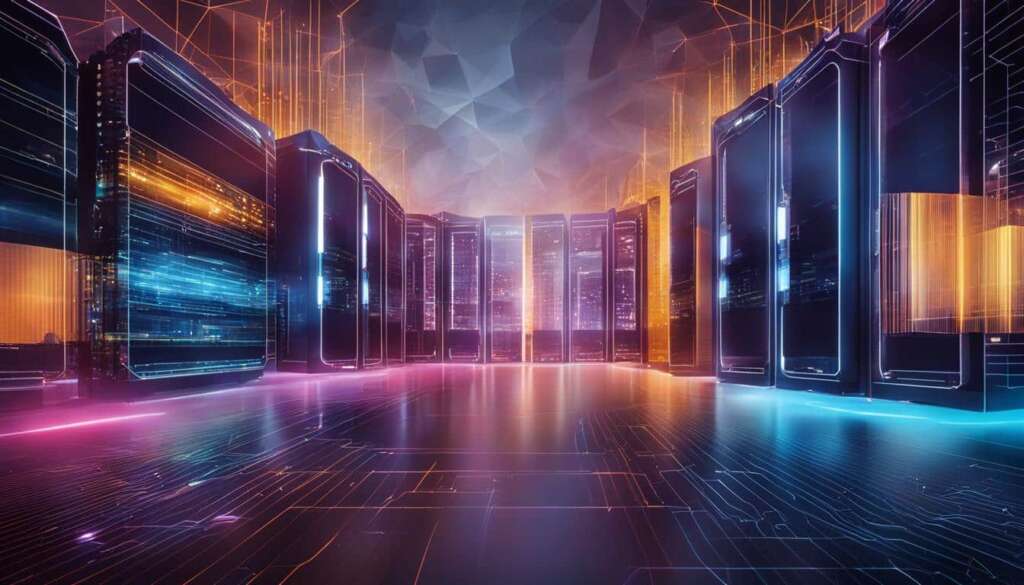Table of Contents
Fog computing is a decentralized infrastructure that brings storage and processing components closer to the edge of the cloud, where data sources such as application users and sensors exist. It aims to overcome the challenges of data latency and network bandwidth in the era of massive data generation. Fog computing is closely related to cloud computing and edge computing, and it plays a crucial role in enabling real-time analytics and improving efficiency in the Internet of Things (IoT).
By bringing computation and storage closer to the data source, fog computing minimizes data transmission delays and optimizes the use of network resources. It offers numerous benefits such as reduced latency, enhanced security, improved customer experience, and conservation of network bandwidth. Various industries, including smart homes, smart cities, video surveillance, and healthcare, are leveraging fog computing to achieve better results in terms of network efficiency and data processing.
In this article, we will delve deeper into what fog computing is, explore its basic components, examine real-world examples and use cases, discuss the differences between fog computing and edge computing, and highlight the benefits and challenges associated with fog computing. By the end of this article, you will have a comprehensive understanding of fog computing and how it can revolutionize the way we handle data in a connected world.
What Is Fog Computing?
Fog computing is a decentralized infrastructure that extends the cloud by placing storage and processing components at the edge of the network, closer to where data sources such as application users and sensors exist. It aims to overcome the limitations of cloud computing in terms of data latency and network bandwidth by enabling data processing and analysis at or near the edge of the network.
Fog computing architecture involves the usage of devices with lower processing capabilities to share some of the cloud’s load and handle short-term and time-critical analytics. Edge computing, which is a subset of fog computing, involves processing data right at the point of creation on devices such as routers, cameras, and sensors. Fog computing introduces a layer between the edge devices and the cloud, consisting of small computing servers that collaborate to handle pre-processing, short-term storage, and real-time monitoring of data. This architecture reduces data transportation and improves overall efficiency.
Key Components of Fog Computing Architecture
| Component | Description |
|---|---|
| Edge Devices | Devices such as sensors, routers, and cameras that generate data at the network edge. |
| Fog Nodes | Computing servers positioned between the edge devices and the cloud that handle pre-processing, short-term storage, and real-time monitoring of data. |
| Data Processors | Software or algorithms running on fog nodes that filter, trim, and process data from various sources. |
| Resource Manager | Component responsible for allocating and deallocating resources to different nodes and scheduling data transfer between nodes and the cloud. |
| Security Tools | Tools and protocols that ensure the privacy and integrity of data transmitted within the fog computing infrastructure. |
| Applications | Software or services that utilize the processed data to provide value-added services to end-users. |
Basic Components of Fog Computing
Fog computing, a vital infrastructure for efficient data processing and analysis, comprises several essential components. These components collaborate seamlessly, enabling the seamless functioning of fog computing. The key components of fog computing are physical and virtual nodes, fog nodes, monitoring services, data processors, resource manager, security tools, and applications.
Physical and virtual nodes serve as the crucial points of contact with the real world in fog computing. Examples of physical nodes include application servers, edge routers, mobile devices, and sensors. Virtual nodes, on the other hand, are virtual representations of physical entities, enabling the efficient allocation and management of resources. These nodes create the necessary connectivity and bridge the gap between the edge devices and fog computing infrastructure.
Fog nodes play a vital role in collecting and storing data generated by various sources. Fog nodes are further categorized as fog devices, fog servers, or gateways. They act as data collection points, ensuring efficient storage and retrieval of data at the network edge.
Monitoring services are crucial in fog computing, as they continuously monitor the system’s performance and resource availability. By keeping track of critical parameters, monitoring services enable efficient communication and resource allocation within the fog computing infrastructure.
Data processors are responsible for filtering, trimming, and processing the data collected from various sources. These processors run on fog nodes, enabling efficient data analysis and preparing the data for further processing or transmission.
The resource manager plays a crucial role in allocating and deallocating resources to different nodes within the fog computing infrastructure. It ensures optimal utilization of resources and schedules data transfer between fog nodes and the cloud, enhancing overall efficiency.
Security tools are fundamental components of fog computing that ensure the privacy and integrity of data transmitted within the infrastructure. These tools implement encryption, authentication, and access control measures, safeguarding sensitive data from unauthorized access or tampering.
Applications are the ultimate beneficiaries of fog computing, leveraging the processed data to provide services to end-users. By harnessing the capabilities of fog computing, applications can offer real-time analytics, personalized experiences, and enhanced efficiency in delivering services.

Summary of Components in Fog Computing
| Component | Description |
|---|---|
| Physical and Virtual Nodes | Serve as points of contact with the real world, enabling connectivity between the edge devices and fog computing infrastructure. |
| Fog Nodes | Collect and store data from various sources, acting as data collection points at the network edge. |
| Monitoring Services | Continuously monitor system performance and resource availability, ensuring efficient communication and resource allocation. |
| Data Processors | Filter, trim, and process data collected from various sources, enabling data analysis and preparation for further processing. |
| Resource Manager | Allocate and deallocate resources, optimize resource utilization, and schedule data transfer between fog nodes and the cloud. |
| Security Tools | Ensure privacy and integrity of data transmitted within the fog computing infrastructure, implementing encryption and access control measures. |
| Applications | Leverage processed data to provide services to end-users, benefiting from the real-time analytics and efficiency offered by fog computing. |
Examples and Use Cases of Fog Computing
Fog computing is a revolutionary technology that finds applications in various industries, enabling efficient data processing and real-time analytics. Let’s explore some examples and use cases that highlight the versatility and relevance of fog computing:
Smart Homes
In smart homes, fog computing plays a crucial role in creating personalized alarm systems, automating events, and optimizing energy usage. By leveraging fog computing, IoT devices within a smart home can communicate and process data locally, reducing reliance on the cloud and improving response times.
Smart Cities
Fog computing is transforming the concept of smart cities by analyzing and processing the massive amount of data generated by sensors located throughout the city. It enables real-time traffic regulation, efficient resource management, and improved overall quality of life for residents.
Video Surveillance
Fog computing is integral to video surveillance systems as it allows for real-time processing and analysis of continuous video streams. By leveraging fog computing capabilities, video surveillance systems can reduce latency, lower storage costs, and enhance overall security.
Healthcare
In the healthcare industry, fog computing is instrumental in ensuring real-time monitoring and analysis of patient data while complying with stringent regulations such as HIPAA. By processing data locally, fog computing helps healthcare providers deliver better care, improve patient outcomes, and enhance operational efficiency.
These examples demonstrate how fog computing enables efficient data processing, real-time analytics, and improved network efficiency in a variety of domains such as smart homes, smart cities, video surveillance, and healthcare.
| Industry | Use Case |
|---|---|
| Smart Homes | Create personalized alarm systems, automate events, optimize energy usage |
| Smart Cities | Real-time traffic regulation, efficient resource management |
| Video Surveillance | Real-time processing and analysis of continuous video streams |
| Healthcare | Real-time monitoring and analysis of patient data |
Fog Computing vs. Edge Computing
Fog computing and edge computing are often used interchangeably, but they have slight differences in terms of where the intelligence and compute power are placed. In fog computing, intelligence is mainly located at the local area network, and data is transmitted from endpoints to a fog gateway for processing. This allows for quick analytics and decision-making at the edge of the network.
Edge computing, on the other hand, can have intelligence and power at both the endpoint and gateway levels, offering more flexibility in distributing computing resources. Proponents of fog computing emphasize its scalability and ability to provide a big-picture view of the network, while edge computing focuses on reducing points of failure by enabling independent operation of devices.
Both fog computing and edge computing contribute to improving network efficiency and enabling real-time processing of data.

As seen in the image above, the key differences between fog computing and edge computing lie in the placement of intelligence, compute power, and distribution of computing resources. These differences determine how data is processed and where the processing takes place, ultimately influencing the scalability and network efficiency of each approach.
Benefits and Challenges of Fog Computing
Fog computing offers several benefits to organizations, ranging from reduced latency and improved security to enhanced customer experience and network bandwidth conservation. By processing data at or near the edge of the network, fog computing significantly reduces the time required for data transmission, resulting in quicker response times that positively impact user experience. With fog computing, the physical location of data processing resources becomes less critical, enabling organizations to deliver real-time services to users regardless of their geographical location.
The enhanced security provided by fog computing is another significant advantage. By decentralizing computing infrastructure, fog computing makes it more challenging for hackers to disrupt or breach sensitive data. Data can be processed and stored within the fog nodes, minimizing the exposure of critical information to external threats. This enhanced security ensures that organizations can protect their data and maintain the privacy and integrity of user information more effectively.
In addition to reduced latency and improved security, fog computing also helps conserve network bandwidth. By minimizing the volume of data sent to the cloud for processing, organizations can optimize their network resources and reduce costs associated with data transmission. This efficient utilization of network bandwidth enables organizations to handle larger volumes of data without overwhelming their network infrastructure.
Despite the numerous benefits it offers, fog computing also presents certain challenges that organizations need to consider. One of the significant challenges is the physical location dependency. Fog computing requires the presence of edge devices and fog nodes in close proximity to the data sources, which may limit its applicability in certain scenarios. Companies need to evaluate their specific requirements and consider the deployment of fog computing in locations where data processing at the edge is vital.
Another challenge associated with fog computing is potential security issues. While fog computing enhances security, it also introduces additional layers to the network infrastructure, which may create potential vulnerabilities if not adequately addressed. Organizations need to implement robust security measures, including encryption, access controls, and monitoring systems, to mitigate these risks and ensure the integrity of their fog computing environment.
Furthermore, fog computing may involve startup costs associated with the acquisition and implementation of the necessary hardware and infrastructure. Organizations should carefully assess the cost-benefit analysis and evaluate the long-term advantages of fog computing against the initial investment required.
Lastly, concept ambiguity is another challenge organizations may face when adopting fog computing. As a relatively new technology, fog computing still lacks a universally agreed-upon definition and implementation framework. This ambiguity can lead to confusion and inconsistency in understanding and implementing fog computing solutions. Organizations should invest time in gaining a clear understanding of fog computing concepts and seek expert guidance to minimize any risks associated with the lack of standardization.
In summary, fog computing offers significant benefits, including reduced latency, improved security, enhanced customer experience, and network bandwidth conservation. However, organizations need to address the challenges related to physical location dependency, potential security issues, startup costs, and concept ambiguity to fully leverage the advantages of fog computing and optimize their data processing capabilities.
Conclusion
Fog computing is a decentralized computing infrastructure that brings storage and processing components closer to the edge of the network, enabling real-time analytics and improving network efficiency. It complements cloud computing and edge computing by providing the capabilities to process data at or near the source, overcoming the challenges of data latency and network bandwidth.
Fog computing offers numerous benefits. By minimizing data transmission delays, fog computing reduces latency and ensures real-time analytics, enhancing the overall customer experience. Additionally, bringing computation and storage closer to the data source improves security by decentralizing the infrastructure and mitigating potential security risks associated with cloud computing.
Various industries, including smart homes, smart cities, video surveillance, and healthcare, are leveraging fog computing to achieve better results in terms of network efficiency and data processing. While fog computing presents challenges such as physical location dependency and potential security issues, its advantages, including improved customer experience and conservation of network bandwidth, outweigh the drawbacks.
By understanding the benefits and best practices of fog computing, organizations can harness its power to revolutionize data handling and achieve better results in terms of efficiency and real-time analytics.
FAQ
What is fog computing?
Fog computing is a decentralized infrastructure that extends the cloud by placing storage and processing components at the edge of the network, closer to where data sources such as application users and sensors exist. It aims to overcome the limitations of cloud computing in terms of data latency and network bandwidth by enabling data processing and analysis at or near the edge of the network.
What are the basic components of fog computing?
The basic components of fog computing include physical and virtual nodes, fog nodes, monitoring services, data processors, resource manager, security tools, and applications. Physical and virtual nodes serve as the points of contact with the real world, such as application servers, edge routers, mobile devices, and sensors. Fog nodes collect and store the generated data, while monitoring services keep track of the system’s performance and resource availability. Data processors filter, trim, and process the data, while the resource manager allocates and deallocates resources. Security tools ensure data privacy and integrity, and applications utilize the processed data to provide services to end-users.
What are some examples and use cases of fog computing?
Fog computing has applications in various industries such as smart homes, smart cities, video surveillance, and healthcare. In smart homes, fog computing can be used to create personalized alarm systems, automate events, and optimize energy usage. In smart cities, fog computing enables real-time traffic regulation and efficient resource management. Video surveillance systems rely on fog computing to process continuous streams of video data, reducing latency and storage costs. In healthcare, fog computing ensures real-time monitoring and analysis of patient data while maintaining compliance with regulations.
What is the difference between fog computing and edge computing?
While fog computing and edge computing are often used interchangeably, they have slight differences in terms of where the intelligence and compute power are placed. In fog computing, intelligence is mainly located at the local area network, and data is transmitted from endpoints to a fog gateway for processing. Edge computing, on the other hand, can have intelligence and power at both the endpoint and gateway levels. Fog computing provides a big-picture view of the network, while edge computing focuses on reducing points of failure by enabling independent operation of devices.
What are the benefits and challenges of fog computing?
Fog computing offers benefits such as reduced latency, improved security, enhanced customer experience, and conservation of network bandwidth. By processing data at or near the edge of the network, fog computing minimizes the time required for data transmission and improves user experience. It also enhances security by decentralizing computing infrastructure. However, fog computing also presents challenges such as physical location dependency, potential security issues, startup costs associated with hardware, and ambiguity in its definition and implementation. These challenges need to be addressed and mitigated to fully leverage the benefits of fog computing.
Why should organizations consider implementing fog computing?
Organizations should consider implementing fog computing to improve network efficiency, enable real-time analytics, and handle the challenges of data latency and network bandwidth. Fog computing complements cloud computing and edge computing by processing data at or near the source, enhancing security, and conserving network bandwidth. By understanding the benefits and best practices of fog computing, organizations can revolutionize data handling and achieve better results in terms of efficiency and real-time analytics.













